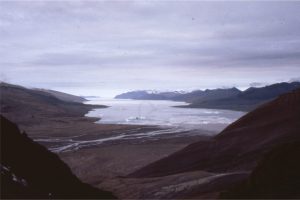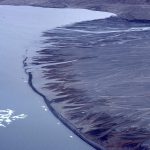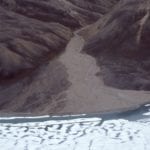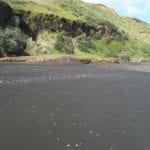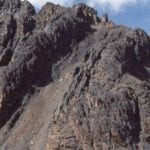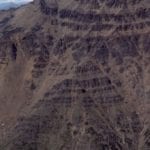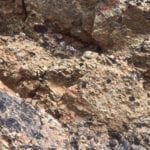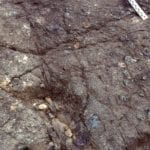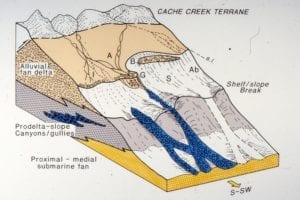Fan deltas are like alluvial fans except they dip their toes in lakes and shallow seas. So, in addition to the alluvial component, there is subaqueous deposition down a relatively steep, angle-of-repose slope. Sedimentation along the delta front, or slope, commonly produces large, basinward-dipping foresets, one of the defining characteristics of fan deltas.
Fan delta deposits are generally coarse-grained; there is much sand and gravel. Distributary systems tend to be braided. Sediment is supplied to the delta front from where it avalanches down-slope or transforms to debris flows. Gravitational instability may also influence depositional mechanisms.
Fan deltas tend to accumulate where there is a decent supply of sediment; close to steep uplands, active faults, mountain fronts, thrust fronts, glacial lakes and fiords, and pull-apart basins. Deposition outboard of active extension faults can produce spectacular fan delta stacks on the hanging-wall block. Fan deltas associated with thrust faults may accumulate as basinward overlapping packages in the footwall, that are subsequently overthrust. In pull-apart basins, the locus of fan delta stacking parallels strike-slip displacement; often likened to a horizontal stack of dominoes – the Devonian Hornelen Basin (Norway) and Late Miocene Ridge Basin (California) are classic examples.
Here’s a paper on Bowser Basin fan deltas: Ricketts, B.D., and Evenchick, C.A. 2007. Evidence of different contractional styles along foredeep margins provided by Gilbert deltas; examples from Bowser Basin, British Columbia, Canada: Bulletin of the Canadian Petroleum Geologists, v. 55, p. 243-261.
This link will take you to an explanation of the Atlas series, the ownership, use and acknowledgment of images. There, you will also find links to the other categories.
Click on the image for an expanded view, then ‘back page’ arrow to return to the Atlas.
The images:
 A sizeable fan delta encroaching into Tanquary Fiord, Ellesmere Island. Arrow points to a Geological Survey of Canada base camp in 1988. The gravel delta top and foreslope are derived from Paleozoic rocks.
A sizeable fan delta encroaching into Tanquary Fiord, Ellesmere Island. Arrow points to a Geological Survey of Canada base camp in 1988. The gravel delta top and foreslope are derived from Paleozoic rocks.
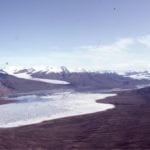 The head of Strand Fiord, Axel Heiberg Island, contains a braid-plain fan delta (center), the outwash drainage from Strand Glacier (distant right). A smaller, ‘radial’ fan delta is growing along the south (right) fiord shore. See image below for a different perspective of this fan delta.
The head of Strand Fiord, Axel Heiberg Island, contains a braid-plain fan delta (center), the outwash drainage from Strand Glacier (distant right). A smaller, ‘radial’ fan delta is growing along the south (right) fiord shore. See image below for a different perspective of this fan delta.
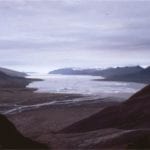 Looking west along Strand Fiord (Axel Heiberg Island); several small fan deltas drain the bordering ridges. In the foreground is the fan delta shown in the preceding image, fed by a braided river.
Looking west along Strand Fiord (Axel Heiberg Island); several small fan deltas drain the bordering ridges. In the foreground is the fan delta shown in the preceding image, fed by a braided river.
Typical Arctic fan deltas: Left Slidre Fiord. Braided stream supply to the delta front is clear, with the active channels regularly moving across the delta top. A gravel beach ridge formed along the inactive delta front, has become detached. Right: Small, steep sloped fan delta along Emma Fiord.
This small, very recent, dissected fan delta accumulated on the beach face at Kariotahi, south Auckland (Tasman Sea coast). Storm drainage through the weakly indurated Pleistocene dune-beach sands behind, deposited sand during high tide. The small delta built across the beach, and as the tide ebbed, the stream eroded into its delta. The overall concave (down) top surface is evident in both images.
 Cross-section through the Kariotahi mini fan delta. Mostly Laminated and rippled sand and a few mud stringers, with a layer of disrupted sand-mud at the red arrow.
Cross-section through the Kariotahi mini fan delta. Mostly Laminated and rippled sand and a few mud stringers, with a layer of disrupted sand-mud at the red arrow.
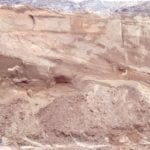 Pleistocene Gilbert delta exposed in the Bradner Road pit, Fraser Valler, Vancouver. The dipping foresets have a clear topset sand unit (laminated and small crossbeds). Foresets show numerous pinchouts and local discordances, probably reflecting changing stream flow and sediment supply, and possibly local slumping down the foreslope. The delta is at least 6m thick. It accumulated in a glacial outwash lake. The overlying grey deposit is a diamictite.
Pleistocene Gilbert delta exposed in the Bradner Road pit, Fraser Valler, Vancouver. The dipping foresets have a clear topset sand unit (laminated and small crossbeds). Foresets show numerous pinchouts and local discordances, probably reflecting changing stream flow and sediment supply, and possibly local slumping down the foreslope. The delta is at least 6m thick. It accumulated in a glacial outwash lake. The overlying grey deposit is a diamictite.
 An impressive stack of Upper Jurassic fan deltas in Bowser Basin, northern British Columbia. Each delta package is separated by recessive, interfan turbidites and mudstone. The stack accumulated during active faulting close to the basin margin. Icebox Canyon.
An impressive stack of Upper Jurassic fan deltas in Bowser Basin, northern British Columbia. Each delta package is separated by recessive, interfan turbidites and mudstone. The stack accumulated during active faulting close to the basin margin. Icebox Canyon.
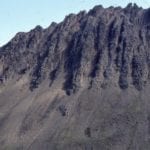 A different perspective of the Icebox Canyon fan delta stack: fan foresets are dipping towards the viewer (top to the left). Some fan packages coalesce, others are separated by thin turbiditic sandstone and mudstone.
A different perspective of the Icebox Canyon fan delta stack: fan foresets are dipping towards the viewer (top to the left). Some fan packages coalesce, others are separated by thin turbiditic sandstone and mudstone.
Closer view of delta packages, shows foresets, and thin bedded interfan deposits. Icebox Canyon, Bowser Basin
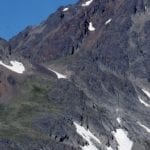 Foreset geometry is clearly expressed in this view of the Icebox Canyon fan delta stack
Foreset geometry is clearly expressed in this view of the Icebox Canyon fan delta stack
 Interfan turbidites, mostly Tb-d components of Bouma cycles. Top to the right.
Interfan turbidites, mostly Tb-d components of Bouma cycles. Top to the right.
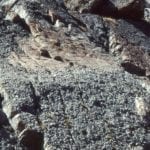 Gravel ripples developed along some fan delta foresets, indicating some down-slope bedload movement of sand and gravel. Icebox Canyon, Bowser Basin.
Gravel ripples developed along some fan delta foresets, indicating some down-slope bedload movement of sand and gravel. Icebox Canyon, Bowser Basin.
Clear discordances between foreset conglomerate beds, and topset conglomerates in fan deltas at Mt. Cartmel (left), and Tsargoss Lake (right). Topset beds at Mt. Cartmel contain planar and trough crossbedded, clast-supported conglomerate that is interpreted as the briaded, alluvial portion of the fan delta. Bowser Basin.
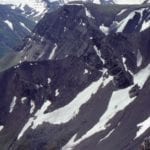 Some fan Deltas in Bowser Basin, migrated to the shelf-slope break, and were probably instrumental in supplying gravel to the deeper basin submarine gullies, canyons, and submarine fans. Here, foreset toes interfinger with slope shale and thin sandstone. West of Tsatia Mt.
Some fan Deltas in Bowser Basin, migrated to the shelf-slope break, and were probably instrumental in supplying gravel to the deeper basin submarine gullies, canyons, and submarine fans. Here, foreset toes interfinger with slope shale and thin sandstone. West of Tsatia Mt.
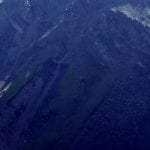 Admittedly a bit dark, but look closely and you will see fan delta foreset toes interfingering with slope mudrocks, and overlying the delta, coarsening-upward shelf deposits. West of Tsatia Mt, Bowser Basin.
Admittedly a bit dark, but look closely and you will see fan delta foreset toes interfingering with slope mudrocks, and overlying the delta, coarsening-upward shelf deposits. West of Tsatia Mt, Bowser Basin.
Non-cohesive – greater degree of clast-support (left) and cohesive-muddy (right) debris flow conglomerate composing some fan delta foresets at the Mt Cartmel delta.
Reconstruction of fan delta-shelf and shelf-break gullies, outboard of active Late Jurassic thrusting, Bowser Basin, BC. For details, see: Ricketts, B.D., and Evenchick, C.A. 2007. Evidence of different contractional styles along foredeep margins provided by Gilbert deltas; examples from Bowser Basin, British Columbia, Canada: Bulletin of the Canadian Petroleum Geologists, v. 55, p. 243-261.

